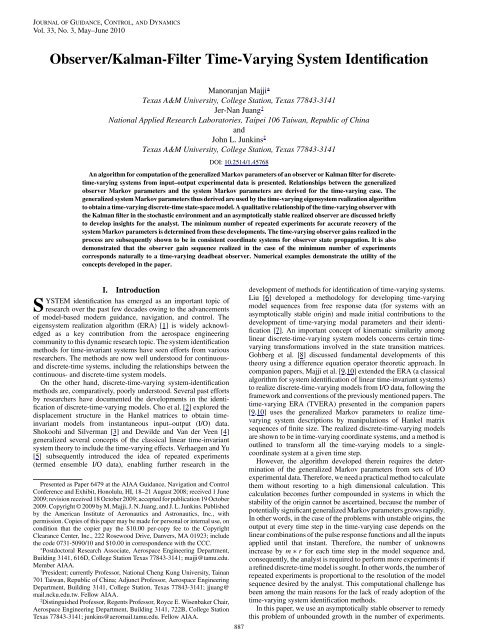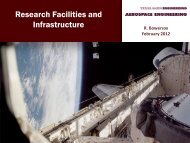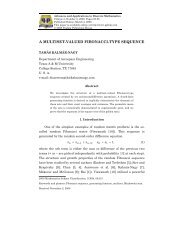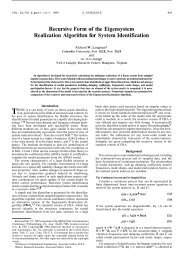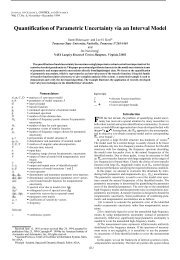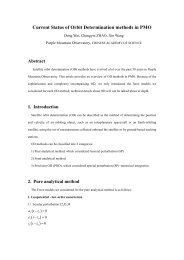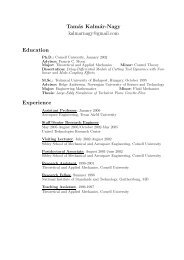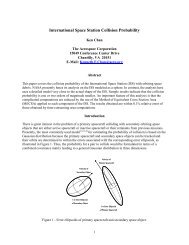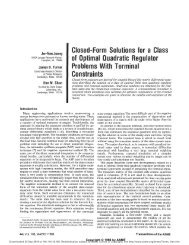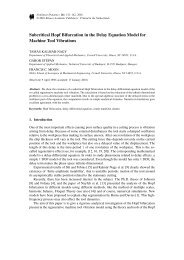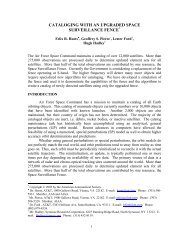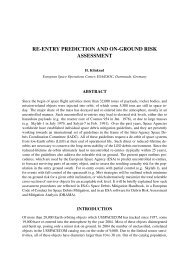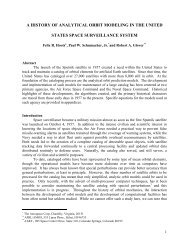Observer/Kalman-Filter Time-Varying System Identification - AIAA
Observer/Kalman-Filter Time-Varying System Identification - AIAA
Observer/Kalman-Filter Time-Varying System Identification - AIAA
Create successful ePaper yourself
Turn your PDF publications into a flip-book with our unique Google optimized e-Paper software.
JOURNAL OF GUIDANCE,CONTROL, AND DYNAMICS<br />
Vol. 33, No. 3, May–June 2010<br />
<strong>Observer</strong>/<strong>Kalman</strong>-<strong>Filter</strong> <strong>Time</strong>-<strong>Varying</strong> <strong>System</strong> <strong>Identification</strong><br />
Manoranjan Majji ∗<br />
Texas A&M University, College Station, Texas 77843-3141<br />
Jer-Nan Juang †<br />
National Applied Research Laboratories, Taipei 106 Taiwan, Republic of China<br />
and<br />
John L. Junkins ‡<br />
Texas A&M University, College Station, Texas 77843-3141<br />
DOI: 10.2514/1.45768<br />
An algorithm for computation of the generalized Markov parameters of an observer or <strong>Kalman</strong> filter for discretetime-varying<br />
systems from input–output experimental data is presented. Relationships between the generalized<br />
observer Markov parameters and the system Markov parameters are derived for the time-varying case. The<br />
generalized system Markov parameters thus derived are used by the time-varying eigensystem realization algorithm<br />
to obtain a time-varying discrete-time state-space model. A qualitative relationship of the time-varying observer with<br />
the <strong>Kalman</strong> filter in the stochastic environment and an asymptotically stable realized observer are discussed briefly<br />
to develop insights for the analyst. The minimum number of repeated experiments for accurate recovery of the<br />
system Markov parameters is determined from these developments. The time-varying observer gains realized in the<br />
process are subsequently shown to be in consistent coordinate systems for observer state propagation. It is also<br />
demonstrated that the observer gain sequence realized in the case of the minimum number of experiments<br />
corresponds naturally to a time-varying deadbeat observer. Numerical examples demonstrate the utility of the<br />
concepts developed in the paper.<br />
I. Introduction<br />
SYSTEM identification has emerged as an important topic of<br />
research over the past few decades owing to the advancements<br />
of model-based modern guidance, navigation, and control. The<br />
eigensystem realization algorithm (ERA) [1] is widely acknowledged<br />
as a key contribution from the aerospace engineering<br />
community to this dynamic research topic. The system identification<br />
methods for time-invariant systems have seen efforts from various<br />
researchers. The methods are now well understood for continuousand<br />
discrete-time systems, including the relationships between the<br />
continuous- and discrete-time system models.<br />
On the other hand, discrete-time-varying system-identification<br />
methods are, comparatively, poorly understood. Several past efforts<br />
by researchers have documented the developments in the identification<br />
of discrete-time-varying models. Cho et al. [2] explored the<br />
displacement structure in the Hankel matrices to obtain timeinvariant<br />
models from instantaneous input–output (I/O) data.<br />
Shokoohi and Silverman [3] and Dewilde and Van der Veen [4]<br />
generalized several concepts of the classical linear time-invariant<br />
system theory to include the time-varying effects. Verhaegen and Yu<br />
[5] subsequently introduced the idea of repeated experiments<br />
(termed ensemble I/O data), enabling further research in the<br />
Presented as Paper 6479 at the <strong>AIAA</strong> Guidance, Navigation and Control<br />
Conference and Exhibit, Honolulu, HI, 18–21 August 2008; received 1 June<br />
2009; revision received 18 October 2009; accepted for publication 19 October<br />
2009. Copyright © 2009 by M. Majji, J. N. Juang, and J. L. Junkins. Published<br />
by the American Institute of Aeronautics and Astronautics, Inc., with<br />
permission. Copies of this paper may be made for personal or internal use, on<br />
condition that the copier pay the $10.00 per-copy fee to the Copyright<br />
Clearance Center, Inc., 222 Rosewood Drive, Danvers, MA 01923; include<br />
the code 0731-5090/10 and $10.00 in correspondence with the CCC.<br />
∗ Postdoctoral Research Associate, Aerospace Engineering Department,<br />
Building 3141, 616D, College Station Texas 77843-3141; majji@tamu.edu.<br />
Member <strong>AIAA</strong>.<br />
† President; currently Professor, National Cheng Kung University, Tainan<br />
701 Taiwan, Republic of China; Adjunct Professor, Aerospace Engineering<br />
Department, Building 3141, College Station, Texas 77843-3141; jjuang@<br />
mail.ncku.edu.tw. Fellow <strong>AIAA</strong>.<br />
‡ Distinguished Professor, Regents Professor, Royce E. Wisenbaker Chair,<br />
Aerospace Engineering Department, Building 3141, 722B, College Station<br />
Texas 77843-3141; junkins@aeromail.tamu.edu. Fellow <strong>AIAA</strong>.<br />
887<br />
development of methods for identification of time-varying systems.<br />
Liu [6] developed a methodology for developing time-varying<br />
model sequences from free response data (for systems with an<br />
asymptotically stable origin) and made initial contributions to the<br />
development of time-varying modal parameters and their identification<br />
[7]. An important concept of kinematic similarity among<br />
linear discrete-time-varying system models concerns certain timevarying<br />
transformations involved in the state transition matrices.<br />
Gohberg et al. [8] discussed fundamental developments of this<br />
theory using a difference equation operator theoretic approach. In<br />
companion papers, Majji et al. [9,10] extended the ERA (a classical<br />
algorithm for system identification of linear time-invariant systems)<br />
to realize discrete-time-varying models from I/O data, following the<br />
framework and conventions of the previously mentioned papers. The<br />
time-varying ERA (TVERA) presented in the companion papers<br />
[9,10] uses the generalized Markov parameters to realize timevarying<br />
system descriptions by manipulations of Hankel matrix<br />
sequences of finite size. The realized discrete-time-varying models<br />
are shown to be in time-varying coordinate systems, and a method is<br />
outlined to transform all the time-varying models to a singlecoordinate<br />
system at a given time step.<br />
However, the algorithm developed therein requires the determination<br />
of the generalized Markov parameters from sets of I/O<br />
experimental data. Therefore, we need a practical method to calculate<br />
them without resorting to a high dimensional calculation. This<br />
calculation becomes further compounded in systems in which the<br />
stability of the origin cannot be ascertained, because the number of<br />
potentially significant generalized Markov parameters grows rapidly.<br />
In other words, in the case of the problems with unstable origins, the<br />
output at every time step in the time-varying case depends on the<br />
linear combinations of the pulse response functions and all the inputs<br />
applied until that instant. Therefore, the number of unknowns<br />
increase by m r for each time step in the model sequence and,<br />
consequently, the analyst is required to perform more experiments if<br />
arefined discrete-time model is sought. In other words, the number of<br />
repeated experiments is proportional to the resolution of the model<br />
sequence desired by the analyst. This computational challenge has<br />
been among the main reasons for the lack of ready adoption of the<br />
time-varying system identification methods.<br />
In this paper, we use an asymptotically stable observer to remedy<br />
this problem of unbounded growth in the number of experiments.
888 MAJJI, JUANG, AND JUNKINS<br />
The algorithm developed as a consequence is called the time-varying<br />
observer/<strong>Kalman</strong>-filter system identification (TOKID). In addition,<br />
the tools systematically presented in this paper give an estimate<br />
on the minimum number of experiments needed to perform<br />
identification and/or recovery of all the Markov parameters of<br />
interest until that time instant. Thus, the central result of the current<br />
paper is to make the number of repeated experiments independent of<br />
the desired resolution of the model. Furthermore, because the<br />
frequency response functions for time-varying systems are not well<br />
known, the method outlined seems to be one of the first practical<br />
ways to obtain the generalized Markov parameters, bringing the<br />
time-varying identification methods to the table of the practicing<br />
engineer.<br />
Novel models relating I/O data are developed in this paper and are<br />
found to be elegant extensions of the autoregressive exogenous input<br />
(ARX) models, well known in the analysis of time-invariant models<br />
(cf., Juang et al. [11]). The ARX model is a linear difference equation<br />
that relates the input to the output. This generalization of the classical<br />
ARX model to the time-varying case admits analogous recursive<br />
relations with the system Markov parameters, as was developed in<br />
the time-invariant case. This analogy is shown to go even further and<br />
enable us to realize a deadbeat observer gain sequence for timevarying<br />
systems. The generalization of this deadbeat definition is<br />
rather unique and general for the time-varying systems, as it is shown<br />
that not all the closed-loop time-varying eigenvalues need to be zero<br />
for the time-varying observer gain sequence to be called deadbeat.<br />
Furthermore, it is demonstrated that the time-varying observer<br />
sequence (deadbeat or otherwise) computed from the ARX model is<br />
realized in a compatible coordinate system with the identified plant<br />
model sequence. Relations with the time-varying <strong>Kalman</strong> filter are<br />
made, comparing with the time-varying observer gains realized from<br />
the TOKID procedure presented in the paper.<br />
II. Basic Formulation<br />
We start by revisiting the relations between the I/O sets of vectors<br />
via the system Markov parameters, as developed in the theory<br />
concerning the TVERA (refer to companion paper [9], based on [10],<br />
and the references therein). The fundamental difference equations<br />
governing the evolution of a linear system in discrete time are given<br />
by<br />
together with the measurement equations:<br />
x k 1 A k x k B k u k (1)<br />
y k C k x k D k u k (2)<br />
with the state, output, and input dimensions x k 2 R n , y k 2 R m , and<br />
u k 2 R r , and the system matrices to be of compatible dimensions<br />
8 k 2 Z, an index set. The solution of the state evolution (the linear<br />
time-varying discrete-time difference equation solution) is given by<br />
X k 1<br />
x k k; k 0 x 0 k; i 1 B i u i (3)<br />
i k 0<br />
8 k k 0 1, where the state transition matrix :; : is defined as<br />
8<br />
< A k 1 ;A k 2 ; ... ;A k0<br />
8 k>k 0<br />
k; k 0 I k k<br />
:<br />
0 (4)<br />
undefined 8 k
MAJJI, JUANG, AND JUNKINS 889<br />
from experimental data. Importantly, for the first time, we are also<br />
able to isolate a minimum number of repeated experiments to help the<br />
practicing engineer plan the experiments required for identification<br />
a priori.<br />
Following the observations of the previous researchers, consider<br />
the use of a time-varying output–feedback-style gain sequence in the<br />
difference model [Eq. (1)], producing<br />
x k 1 A k x k B k u k G k y k G k y k<br />
A k G k C k x k B k G k D k u k G k y k<br />
" #<br />
A k x k B k G k D<br />
. u k<br />
k A k x k B k v k (9)<br />
with the definitions:<br />
A k A k G k C k ; B k B k G k D k G k ; v k<br />
u k<br />
y k<br />
(10)<br />
and no change in the measurement equations at the time step t k :<br />
G k<br />
y k<br />
y k C k x k D k u k (11)<br />
The outputs at the consecutive time steps, starting from the initial<br />
time step t 0 (denoted by k 0 0) are therefore written as<br />
y 0 C 0 x 0 D 0 u 0 ;<br />
y 1 C 1 A 0 x 0 D 1 u 1 C 1 B 0 v 0 C 1 A 0 x 0 D 0 u 0 h 1;0 v 0 ;<br />
y 2 C 2 A 1 A 0 x 0 D 2 u 2 C 2 B 1 v 1 C 2 A 1 B 0 v 0<br />
.<br />
C 2 A 1 A 0 x 0 D 2 u 2 h 2;1 v 1 h 2;0 v 0 ;<br />
(12)<br />
with the definition of the generalized observer Markov parameters:<br />
8<br />
< C k A k 1 ; A k 2 ; ... ; A i 1 B i 8 k>i 1<br />
h k;i C<br />
: k B k 1 k i 1<br />
0 8 kp), we have<br />
2 3<br />
u k<br />
v k 1<br />
y k D k h k;k 1 h k;k 2 ... h v k 2<br />
k;k p (17)<br />
6 . 7<br />
4<br />
5<br />
v k p<br />
This represents a set of m equations in m r p r m<br />
unknowns. In contrast to the developments using the generalized<br />
system Markov parameters (to relate the I/O data sets, refer to Eq. (8)<br />
in the companion papers [9,10] and the references therein for more<br />
information), the number of unknowns remains constant in this case.<br />
This makes the computation of observer Markov parameters possible<br />
in practice, because the number of repeated experiments required to<br />
compute these parameters is now constant (derived next) and does
890 MAJJI, JUANG, AND JUNKINS<br />
not change with the discrete-time step t k . In fact, it is observed that a<br />
minimum of Nexp min r p r m experiments are necessary<br />
to determine the observer Markov parameters uniquely. From the<br />
developments of the subsequent sections, this is the minimum<br />
number of repeated experiments one should perform in order to<br />
realize the time-varying system models desired from the TVERA.<br />
Equation (17), with N repeated experiments, yields:<br />
Y k y 1<br />
k y 2<br />
k ... y N<br />
k<br />
2<br />
3<br />
u 1<br />
k u 2<br />
k u N<br />
k<br />
v 1<br />
k 1 v 2<br />
k 1 v N<br />
k 1<br />
D k h k;k 1 h k;k 2 ... h k;k p<br />
v 1<br />
k 2 v 2<br />
k 2 ... v N<br />
k 2<br />
.<br />
.<br />
. . 6<br />
7<br />
4<br />
5<br />
v 1<br />
k p v 2<br />
k p v N<br />
k p<br />
M k V k (18)<br />
8 k>p. Therefore, the least-squares solution for the generalized<br />
observer Markov parameters is given for each time step as<br />
^M k Y k V † k (19)<br />
where : † denotes the pseudoinverse of a matrix [15,16]. The<br />
calculation of the system Markov parameters and the observer gain<br />
Markov parameters is detailed in the next section.<br />
IV. Computation of Generalized <strong>System</strong> Markov<br />
Parameters and <strong>Observer</strong> Gain Sequence<br />
We first outline a process for the determination of a system Markov<br />
parameter sequence from the observer Markov parameter sequence<br />
calculated in the previous section. A recursive relationship is then<br />
given to obtain the system Markov parameters, with the index<br />
difference of greater than p time steps. Similar procedures are set up<br />
for observer gain Markov parameter sequences.<br />
A. Computation of <strong>System</strong> Markov Parameters from <strong>Observer</strong><br />
Markov Parameters<br />
Considering the definition of the generalized observer Markov<br />
parameters, we write<br />
h k;k 1 C k B k 1<br />
C k B k 1 G k 1 D k 1 G k 1<br />
h 1<br />
k;k 1 h 2<br />
k;k 1<br />
(20)<br />
where the superscripts in Eqs. (1) and (2) are used to distinguish<br />
between the Markov parameter sequences useful to compute the<br />
system parameters and the observer gains, respectively. Observe the<br />
following manipulation, written as<br />
h 1<br />
k;k 1 h 2<br />
k;k 1 D k 1 C k B k 1 h k;k 1 (21)<br />
A similar expression for Markov parameters with two time steps<br />
between them yields:<br />
h 1<br />
k;k 2<br />
h 2<br />
k;k 2 D k 2 C k A k 1 B k 2 C k A k 1 G k 2 D k 2<br />
C k A k 1 B k 2 G k 2 D k 2 C k A k 1 G k 2 D k 2<br />
C k A k 1 B k 2<br />
C k A k 1 G k 1 C k 1 B k 2<br />
C k A k 1 B k 2 h 2<br />
k;k 1 C k 1B k 2<br />
h k;k 2 h 2<br />
k;k 1 h k 1;k 2 (22)<br />
This elegant manipulation leads to an expression for the system<br />
Markov parameter h k;k 2 to be calculated from observer Markov<br />
parameters at the time step t k and the system Markov parameters at<br />
previous time steps. This recursive relationship was found to hold in<br />
general and enables the calculation of the system Markov parameters<br />
(unadorned h i;j ) from the observer Markov parameters h i;j .<br />
To show this holds in general, consider the induction step<br />
with the observer Markov parameters (with p time-step separation)<br />
given by<br />
h 1<br />
k;k p h 2<br />
k;k p D k p C k A k 1 ; A k 2 ; ...; A k p 1 B k p G k p D k p<br />
C k A k 1 ; A k 2 ; ...; A k p<br />
C k A k 1 ; A k 2 ; ...; A k p<br />
1 G k p D k p<br />
1 B k p<br />
C k A k 1; A k 2 ; ...; A k p 2 A k p 1 G k p 1 C k p 1 B k p<br />
C k A k 1 ; A k 2 ; ...; A k p 2 ;A k p 1 B k p<br />
C k A k 1 ; A k 2 ; ...; A k p 2 G k p 1 C k p 1 B k p<br />
C k A k 1 ; A k 2 ; ...; A k p 2 A k p 1 B k p<br />
h 2<br />
k;k p 1 h k p 1;k p (23)<br />
Careful examination reveals that the term<br />
can be written as<br />
C k A k 1 ; A k 2 ; ... ; A k p 2 ; A k p 1 B k p<br />
C k A k 1 ; A k 2 ; ... ; A k p 2 ;A k p 1 B k p<br />
C k A k 1 ; ... ; A k p 3 A k p 2 G k p 2 C k p 2 A k p 1 B k p<br />
C k A k 1 ; ... ;A k p 2 ;A k p 1 B k p<br />
C k A k 1 ; ... ;G k p 2 C k p 2 A k p 1 B k p<br />
C k A k 1 ; ... ;A k p 2 ;A k p 1 B k p h 2<br />
k;k p 2 h k p 2;k p<br />
.<br />
C k A k 1 ; ... ;A k p 1 B k p h 2<br />
k;k 1 h k 1;k p<br />
h 2<br />
k;k 2 h k 2;k p h 2<br />
k;k p 2 h k p 2;k p<br />
h k;k p h 2<br />
k;k 1 h k 1;k p h 2<br />
k;k 2 h k 2;k p<br />
h 2<br />
k;k p 2 h k p 2;k p (24)<br />
This manipulation enables us to write<br />
h 1<br />
k;k p h 2<br />
k;k p D k p<br />
h k;k p h 2<br />
k;k 1 h k 1;k p h 2<br />
k;k 2 h k 2;k p<br />
h k;k p<br />
X p 1<br />
h 2<br />
k;k p 1 h k p 1;k p<br />
j 1<br />
h 2<br />
k;k j h k j;k p (25)<br />
Writing the derived relationships between the system and the<br />
observer Markov parameters yields the following set of equations:<br />
h k;k 1 h 1<br />
k;k 1 h 2<br />
k;k 1 D k 1;<br />
h k;k 2 h 2<br />
k;k 1 h k 1;k 2 h 1<br />
k;k 2<br />
h 2<br />
k;k 2 D k 2<br />
.<br />
h k;k p h 2<br />
k;k 1 h k 1;k p h 2<br />
k;k p 1 h k p 1;k p<br />
h 1<br />
k;k p h 2<br />
k;k p D k p (26)<br />
Defining r i;j<br />
: h 1<br />
i;j h 2<br />
i;j D j , we obtain the system of linear<br />
equations, relating the system and observer Markov parameters as
MAJJI, JUANG, AND JUNKINS 891<br />
2<br />
3<br />
I m h 2<br />
k;k 1 h 2<br />
k;k 2 ... h 2<br />
k;k p 1<br />
0 I m h 2<br />
k 1;k 2 ... h 2<br />
k 1;k p 2<br />
. . . . .<br />
. 6<br />
4<br />
7<br />
5<br />
0 0 0 ... I m<br />
2<br />
3<br />
h k;k 1 h k;k 2 ... h k;k p<br />
0 h k 1;k 2 ... h k 1;k p<br />
. . .<br />
.<br />
.<br />
6<br />
.<br />
7<br />
4<br />
5<br />
0 0 ... h k p 1;k p<br />
2<br />
3<br />
r k;k 1 r k;k 2 ... r k;k p<br />
0 r k 1;k 2 ... r k 1;k p<br />
. . .<br />
. . .<br />
.<br />
6<br />
. .<br />
7<br />
4<br />
5<br />
0 0 ... r k p 1;k p<br />
(27)<br />
We note the striking similarity of this equation to the relation between<br />
the observer Markov parameters and the system Markov parameters<br />
in the classical OKID algorithm for time-invariant systems (compare<br />
the coefficient matrix of Eq. (27) with Eq. 6.8 of Juang [1]).<br />
Considering the expressions for<br />
h k;k p<br />
: C k A k 1 ; ... ; A k p 1 B k p<br />
and choosing a p sufficiently large, we have that, owing to the<br />
asymptotic stability of the closed loop (including the observer),<br />
h k;k p 0. This fact enables us to establish recursive relationships<br />
for the calculation of the system Markov parameters h k;k and<br />
8 >p. Generalizing Eq. (25) produces:<br />
h k;k h 1<br />
k;k h 2<br />
k;k D k<br />
X 1<br />
j 1<br />
h 2<br />
k;k j h k j;k (28)<br />
for p. Then, based on the arguments involving Eq. (17) for the<br />
calculation of the generalized observer Markov parameters, all the<br />
terms with a time-step separation greater than p vanish identically,<br />
and we obtain the relationship:<br />
for<br />
>p.<br />
h k;k<br />
X p<br />
j 1<br />
h 2<br />
k;k j h k j;k (29)<br />
B. Computation of <strong>Observer</strong> Gain Markov Parameters from the<br />
<strong>Observer</strong> Markov Parameters<br />
Consider the generalized observer gain Markov parameters<br />
defined as<br />
h o k;i<br />
8<br />
< C k A k 1 ;A k 2 ; ... ;A i 1 G i 8 k>i 1<br />
C<br />
: k G k 1 k i 1<br />
0 8 kp. Therefore, to calculate the observer gain Markov<br />
parameters, we have a similar upper-block triangular system of linear<br />
equations, which can be written as<br />
2<br />
3<br />
I m h 2<br />
k;k 1<br />
h 2<br />
k;k 2<br />
h 2<br />
k;k p 1<br />
0 I m h 2<br />
k 1;k 2<br />
h 2<br />
k 1;k p 2<br />
. . .<br />
. . .<br />
.<br />
6<br />
4<br />
.<br />
.<br />
7<br />
5<br />
0 0 0 I m<br />
2<br />
3<br />
h o k;k 1 h o k;k 2 h o k;k p<br />
0 h o k 1;k 2 h o k 1;k p<br />
. . .<br />
.<br />
.<br />
6<br />
.<br />
7<br />
4<br />
5<br />
0 0 h o k p 1;k p<br />
2<br />
h 2<br />
k;k 1 h 2<br />
k;k 2 h 2 3<br />
k;k p<br />
0 h 2<br />
k 1;k 2 h 2<br />
k 1;k p<br />
. . . . .<br />
. (36)<br />
6<br />
7<br />
4<br />
5<br />
0 0 h 2<br />
k p 1;k p<br />
to be solved at each time step k. Having outlined a method to compute<br />
the observer gain Markov parameters, let us now proceed to look<br />
at the procedure to extract the observer gain sequence from them.<br />
C. Calculation of the <strong>Time</strong>-<strong>Varying</strong> <strong>Observer</strong> Gain Sequence<br />
From the definition of the observer gain Markov parameters<br />
[Eq. (30)], we can stack the first few parameters in a tall matrix and<br />
observe that
892 MAJJI, JUANG, AND JUNKINS<br />
P k 1<br />
:<br />
2<br />
h o 3 2<br />
3<br />
k 1;k<br />
C k 1 G k<br />
h o k 2;k<br />
C k 2 A k 1 G k<br />
6 . 7 6<br />
.<br />
7<br />
4 . 5 4<br />
.<br />
5<br />
h o k m;k C k m ;A k m 1 ; ... ;A k 1 G k<br />
2<br />
3<br />
C k 1<br />
C k 2 A k 1<br />
6<br />
.<br />
7<br />
4<br />
5 G k O m<br />
k 1 G k (37)<br />
C k m ;A k m 1 ; ... ;A k 1<br />
such that a least-squares solution for the gain matrix at each time step<br />
is given by<br />
G k O m †<br />
k 1 P k 1 (38)<br />
However, from the developments of the companion paper, we find<br />
that it is indeed impossible to determine the observability Gramian<br />
in the true coordinate system [9], as suggested by Eq. (38). The<br />
computed observability Gramian is, in general, in a time-varying and<br />
unknown coordinate system denoted by O m<br />
k 1 at the time step t k 1.<br />
We will now show that the gain computed from this time-varying<br />
observability Gramian (computed) will be consistent with the timevarying<br />
coordinates of the plant model computed by the TVERA<br />
presented in the companion paper. Therefore, upon using the<br />
computed observability Gramian (in its own time-varying coordinate<br />
system) and proceeding with the gain calculation, as indicated by<br />
Eq. (38), we arrive at a consistent computed gain matrix. Given a<br />
transformation matrix T k 1 ,<br />
P k 1 O m<br />
k 1 G k O m<br />
k 1 T k 1Tk<br />
1<br />
such that<br />
^G k Tk<br />
1<br />
1 G k<br />
1 G k<br />
^O m<br />
k 1 T k<br />
1<br />
1 G k<br />
^O m ^G k 1 k<br />
(39)<br />
^O m<br />
k 1 † P k 1 (40)<br />
therefore, with no explicit intervention by the analyst, the realized<br />
gains are automatically in the right coordinate system for producing<br />
the appropriate TOKID closed loop. For consistency, it is often<br />
convenient if one obtains the first few time-step models, as included<br />
in the developments of the companion paper. This automatically<br />
gives the observability Gramians for the first few time steps to<br />
calculate the corresponding observer gain matrix values. To see that<br />
the gain sequence computed by the algorithm is, indeed, in consistent<br />
coordinate systems, recall the identified system and control influence<br />
and the measurement sensitivity matrices in the time-varying<br />
coordinate systems, to be derived as (refer to companion paper [9])<br />
^A k T 1<br />
k 1 A kT k ; ^B k T 1<br />
k 1 B k; ^C k C k T k (41)<br />
The TOKID closed-loop system matrix, with the realized gain matrix<br />
sequence, is seen to be consistently given as<br />
V. Relationship Between the Identified <strong>Observer</strong><br />
and a <strong>Kalman</strong> <strong>Filter</strong><br />
We now qualitatively discuss several features of the observer,<br />
realized from the algorithm presented in the paper. Constructing the<br />
closed loop of the observer dynamics, it can be found to be<br />
asymptotically stable, as purported at the design stage. Following the<br />
developments of the time-invariant OKID paper, we use the wellunderstood<br />
time-varying <strong>Kalman</strong>-filter theory to make some intuitive<br />
observations. These observations help us address the important issue:<br />
variable-order GTV-ARX model fitting of I/O data and what it all<br />
means. Insight is also obtained as to what happens in the presence of<br />
measurement noise. In the practical situation, for which there is the<br />
presence of the process and the measurement noise in the data, the<br />
GTV-ARX model becomes a moving average model that can be<br />
termed as the GTV autoregressive moving average with exogenous<br />
input (GTV-ARMAX) model (generalized is used to indicate<br />
variable order at each time step). A detailed quantitative examination<br />
of this situation is beyond the scope of the current paper: the authors<br />
limit the discussions to qualitative relations.<br />
The <strong>Kalman</strong>-filter equations for a truth model given in Eq. (A1) are<br />
given by<br />
or<br />
^x k 1 A k ^x k B k u k (43)<br />
^x k 1 A k I K k C k ^x k B k u k A k K k y k (44)<br />
together with the propagated output equation<br />
^y k C k ^x k D k u k (45)<br />
where the gain K k is optimal [see expression in Eq. (A16)]. As<br />
documented in the standard estimation theory textbooks, optimality<br />
translates to any one of the equivalent necessary conditions of<br />
minimum variance, maximum likelihood, orthogonality, or Bayesian<br />
schemes. A brief review of the expressions for the optimal gain<br />
sequence is derived in the Appendix A, which also provides an<br />
insight into the useful notion of orthogonality of the discrete<br />
innovations process in addition to deriving an expression for the<br />
optimal gain matrix sequence [see Eq. (A16) for an expression for the<br />
optimal gain]. From an I/O standpoint, the innovations approach<br />
provides the most insight for analysis and is used in this section.<br />
Using the definition of the innovations process " k<br />
: y k ^y k , the<br />
measurement equation of the estimator [shown in Eq. (45)] can be<br />
written in favor of the system outputs, as given by<br />
y k C k ^x k D k u k " k (46)<br />
Rearranging the state propagation shown in Eq. (43), we arrive at a<br />
form given by<br />
^x k 1 A k I K k C k ^x k B k u k A k K k y k<br />
~A k ^x k<br />
~B k v k<br />
(47)<br />
^A k<br />
^G k ^C k T 1<br />
k 1 A k G k C k T k (42)<br />
in a kinematically similar fashion to the true TOKID closed loop. The<br />
nature of the computed stabilizing (deadbeat or near-deadbeat) gain<br />
sequence is best viewed from a reference coordinate system, as<br />
opposed to the time-varying coordinate systems computed by the<br />
algorithm. The projection-based transformations can be used for this<br />
purpose and are discussed in detail in the companion paper [9].<br />
with the definitions<br />
~A k A k I K k C k ; ~B k B k A k K k ; v k<br />
u k<br />
y k<br />
(48)<br />
Notice the structural similarity in the layout of the rearranged<br />
equations to the TOKID equations in Sec. III. This rearrangement<br />
helps in making comparisons and observations as to the conditions in<br />
which we actually manage to obtain the <strong>Kalman</strong>-filter gain sequence<br />
(or otherwise).<br />
Starting from the initial condition, the I/O relation of the <strong>Kalman</strong>filter<br />
equations can be written as
MAJJI, JUANG, AND JUNKINS 893<br />
y 0 C 0 ^x 0 D 0 u 0 " 0 ;<br />
y 1 C 1<br />
~A 0 ^x 0 D 1 u 1 C 1<br />
~B 0 v 0 " 1 ;<br />
y 2 C 2<br />
~A 1<br />
~A 0 ^x 0 D 2 u 2 C 2<br />
~B 1 v 1 C 2<br />
~A 1<br />
~B 0 v 0 " 2<br />
.<br />
.<br />
X<br />
y p C p<br />
~A p 1 ; ... ; ~A p 1<br />
0 ^x 0 D p u p<br />
~h p;p j v p j " p<br />
.<br />
.<br />
suggesting the general relationship<br />
j 1<br />
y k p C k p ; ~A k p 1 ; ...; ~A 0 ^x 0 D k p u k p<br />
kXp 1<br />
j 1<br />
(49)<br />
~h k p;k p j v k p j " k p (50)<br />
with the <strong>Kalman</strong>-filter Markov parameters ~h k;i being defined by<br />
8<br />
< C k<br />
~A k 1 ; ~A k 2 ; ... ; ~A i 1<br />
~B i 8 k>i 1<br />
~h o k;i C<br />
: k<br />
~B k 1 k i 1 (51)<br />
0 8 kp),<br />
if G k A k K k , together with the additional condition that " k 0<br />
and 8 k>p. Therefore, under these conditions, our algorithm is<br />
expected to produce a gain sequence that is optimal. In the presence<br />
of noise in the output data, the additional requirement is to satisfy the<br />
orthogonality (innovations property) of the residual sequence, as<br />
derived in Appendix A.<br />
However, we proceeded to enforce the p (in general p k ) term<br />
dependence in Eq. (16), using the additional freedom obtained<br />
because of the variability of the time-varying observer gains. This<br />
enabled us to minimize the number of repeated experiments and the<br />
number of computations while also arriving at the fastest observer<br />
gain sequence, owing to the definitions of the time-varying deadbeat<br />
observer notions set up in this paper (following the classical<br />
developments of Minamide et al. [13] and Hostetter [14], as<br />
discussed in Appendix B). Notice that the <strong>Kalman</strong>-filter equations<br />
are, in general, not truncated to the first p terms. An immediate<br />
question arises as to whether we can ever obtain the optimal gain<br />
sequence using the truncated representation for gain calculation.<br />
To answer this question qualitatively, we consider the I/O behavior<br />
of the true <strong>Kalman</strong> filter in Eq. (50). Observe that <strong>Kalman</strong> gains<br />
can indeed be constructed so as to obtain matching truncated<br />
representations of the GTV-ARX (more precisely GTV-ARMAX)<br />
model, as in Eq. (16), via the appropriate choice of the tuning<br />
parameters P 0 and Q k , for measurement and process noises. In the<br />
GTV-ARMAX parlance, using a lower order for p (at any given time<br />
step) means the incorporation of a forgetting factor, which in the<br />
<strong>Kalman</strong>-filter framework is tantamount to using larger values for<br />
the process noise parameter Q k (at the same time instant). Therefore,<br />
the GTV-ARX and ARMAX models used for the observer gain<br />
sequence and the system Markov parameter sequence in the<br />
algorithmic developments of this paper are intimately tied into the<br />
tuning parameters of the <strong>Kalman</strong> filter and represent the fundamental<br />
balance existing in the statistical learning theory between the<br />
ignorance of the model for the dynamical system and the<br />
incorporation of new information from the measurements. Further<br />
research is required to develop a more quantitative relation between<br />
the observer identified using the developments of the paper and the<br />
time-varying <strong>Kalman</strong>-filter gain sequence.<br />
VI. Numerical Example<br />
Consider the same system, as presented in an example of the<br />
companion paper [9]. It has an oscillatory nature and does not have a<br />
stable origin. In the case of the time-invariant systems, systems of<br />
oscillatory nature are characterized by poles on the unit circle, and the<br />
origin is said to be marginally stable [17,18]. However, because the<br />
system under consideration is not autonomous, the origin is said to be<br />
unstable in the sense of Lyapunov, as described in [15,19]. A separate<br />
classification has been provided in the theory of nonlinear systems<br />
for systems with an origin of this type. That is called orbital stability<br />
or stability, in the sense of Poincaré (cf., Meirovitch [20]). We follow<br />
the convention of Lyapunov and term the system under consideration<br />
as unstable. In this case, the plant system matrix was calculated as<br />
Fig. 1<br />
Open-loop vs TOKID closed-loop pole locations [10 repeated experiments (i.e., minimum number)]. (TV denotes time-varying.)
894 MAJJI, JUANG, AND JUNKINS<br />
Fig. 2<br />
Error in system Markov parameters (10 repeated experiments).<br />
2 3<br />
1 0<br />
1 1<br />
A k exp A c t ; B k<br />
6 7<br />
4 0 1 5 ;<br />
1 0<br />
(52)<br />
with<br />
A c<br />
0 2 2 I 2 2<br />
K t 0 2 2<br />
(53)<br />
1 0 1 0:2<br />
C k<br />
1 1 0 0:5 ; D k 0:1 1 0<br />
0 1<br />
K t<br />
4 3 k 1<br />
1 7 3 0 k<br />
where the matrix is given by<br />
and k and 0 k are defined as k sin 10t k and 0 k : cos 10t k . The<br />
TOKID algorithm, as described in the main body of the paper, was<br />
Fig. 3<br />
Error in Markov parameter computations (22 repeated experiments).
MAJJI, JUANG, AND JUNKINS 895<br />
applied to this example to calculate the system Markov parameters<br />
and the observer gain Markov parameters from the simulated<br />
repeated experimental data. The system Markov parameters, thus<br />
computed, are used by the TVERA algorithm of the companion<br />
paper to realize the system model sequence for all the time steps for<br />
which experimental data is available. We demonstrate the computation<br />
of the deadbeat-like observer, for which the smallest order for<br />
the GTV-ARX model is chosen throughout the time history of the<br />
identification process. Appendix B details the definition of the timevarying<br />
deadbeat observer for the convenience of the readers, along<br />
with a representative closed-loop sequence result using this example<br />
problem.<br />
In this case, we were able to realize an asymptotically stable closed<br />
loop for the observer equation with TOKID. In fact, two of the<br />
closed-loop eigenvalues could be assigned to zero. The time history<br />
of the open-loop and closed-loop eigenvalues, as viewed from the<br />
coordinate system of the initial condition response decomposition, is<br />
plotted in Fig. 1.<br />
The error incurred in the identification of the system Markov<br />
parameters is in two parts. The system Markov parameters for the<br />
significant number of steps in the GTV-ARX model are, in general,<br />
computed exactly. However, we would still need extra system<br />
Markov parameters to assemble the generalized Hankel matrix<br />
sequence for the TVERA algorithm. These are computed using the<br />
recursive relationships. The truncation of the I/O relationship with<br />
the observer in the loop is exact in theory. Numerical errors still play a<br />
role. The worst-case error, although it is sufficiently small, is incurred<br />
in the situation when a minimum number of experiments is performed.<br />
The magnitude of this error is plotted in Fig. 2 as the matrix 1<br />
norm of the system Markov parameter error sequence (denoted by<br />
k k 1 ). The comparison in this figure is made with an error in the<br />
system Markov parameters computed from the full I/O relationship<br />
without an observer. Performing a larger number of experiments, in<br />
general, leads to better accuracy, as shown in Fig. 3. Note that more<br />
experiments give a better condition number for making the<br />
pseudoinverse of the matrix V k , shown in Eq. (18). The accuracy is<br />
also improved by retaining a larger number of terms (per time step) in<br />
the I/O map.<br />
The error incurred in the system Markov parameter computation is<br />
directly reflected in the output error between the computed and true<br />
Fig. 4<br />
Output error comparison between true and identified plant models (10 repeated experiments).<br />
Fig. 5<br />
Output error comparison between true and identified plant models (22 repeated experiments).
896 MAJJI, JUANG, AND JUNKINS<br />
Fig. 6<br />
Open-loop vs TOKID closed-loop state-error time history (10 repeated experiments).<br />
Fig. 7<br />
Gain history (10 repeated experiments).<br />
system response to the test functions. It was found to be of the same<br />
order of magnitude (and never greater) in several representative<br />
situations incorporating various test cases. The corresponding plots<br />
for Figs. 2 and 3 are shown in Figs. 4 and 5.<br />
Because the considered system is unstable (oscillatory) in nature,<br />
the initial condition response was used to check the nature of the<br />
state-error decay of the system in the presence of the identified<br />
observer. The open-loop response of the system (with no observer in<br />
the loop) and the closed-loop state-error response, including the<br />
realized observer, are plotted in Fig. 6. The plot represents the errors<br />
of convergence of a time-varying deadbeat observer to the true states<br />
of the system. The computed states converge to the true states in<br />
precisely two time steps to zero error response. The analyst should<br />
count the two time steps in question after the first few time steps to<br />
enable the unique identification of the observer gains (a total of four<br />
time steps for this example can be seen in the plots). This decay to<br />
zero was exponential and too steep to plot for the (time-varying)<br />
deadbeat case. However, when the order was chosen to be slightly<br />
higher, a near-deadbeat observer was realized. Therefore, it takes<br />
more than two steps for the response to decay to zero. The gain<br />
history of the realized observer, as seen in the initial condition<br />
coordinate system, is plotted as Fig. 7.<br />
VII. Conclusions<br />
This paper provides an algorithm for efficient computation of<br />
system Markov parameters for use in time-varying system identification.<br />
An observer is inserted in the I/O relations, and this leads
MAJJI, JUANG, AND JUNKINS 897<br />
to effective utilization of the data in computation of the system<br />
Markov parameters. As a by-product, one obtains an observer gain<br />
sequence in the same coordinate system as the system models<br />
realized by the time-varying system identification algorithm. This<br />
observer is further found to be a time-varying deadbeat observer<br />
of the system. Relationship of this observer with a <strong>Kalman</strong> filter is<br />
detailed from an I/O standpoint. It is shown that the flexibility<br />
of a variable-order moving average model realized in the TOKID<br />
computations is related to the forgetting factor introduced by the<br />
process noise tuning parameter of the <strong>Kalman</strong> filter. The working of<br />
the algorithm is demonstrated using a simple example problem.<br />
Appendix A: Review of the Structure and Properties<br />
of the <strong>Kalman</strong> <strong>Filter</strong><br />
I. Linear Estimators of the <strong>Kalman</strong> Type: Review of the Structure<br />
and Properties<br />
We review the structure and properties of the state estimators<br />
for linear discrete-time-varying dynamical systems (<strong>Kalman</strong>-filter<br />
theory [21,22]) using the innovations approach propounded by<br />
Kailath [23] and Mehra [24]. The most commonly used truth model<br />
for the linear time-varying filtering problem is given by<br />
x k 1 A k x k B k u k k w k (A1)<br />
together with the measurement equations given by<br />
y k C k x k D k u k k (A2)<br />
The process noise sequence is assumed to be a Gaussian random<br />
sequence with zero mean E w i 0 8 i and a variance sequence<br />
E w i w T j Q i ij 8 i; j, having an uncorrelated profile in time and<br />
no correlation with the measurement noise sequence E w i v T j 0<br />
8 i; j. Similarly, the measurement noise sequence is assumed to be a<br />
zero mean Gaussian random vector with a covariance sequence given<br />
by E v i v T j R i ij . The Kronecker delta is denoted as ij 0 8 i ≠<br />
j and ij 1 8 i j, along with the usual notation E : for the<br />
expectation operator of random vectors. A typical estimator of<br />
the <strong>Kalman</strong> type (optimal) assumes the structure (following the<br />
notations of [11]):<br />
^x k<br />
^x k K k y k ^y k<br />
: ^x k K k " k (A3)<br />
where the term " k<br />
: y k ^y k represents the so-called innovations<br />
process. In classical estimation theory, this innovations process is<br />
defined to represent the new information brought into the estimator<br />
dynamics through the measurements made at each time instant.<br />
The state transition equations and the corresponding propagated<br />
measurements (most often used to compute the innovations process)<br />
of the estimator are given by<br />
^x k 1 A k ^x k B k u k A k I K k C k ^x k B k u k A k K k y k<br />
(A4)<br />
and<br />
^y k C k ^x k D k u k (A5)<br />
Defining the state estimation error to be given by e k<br />
: x k ^x k<br />
(for analysis purpose), the innovations process is related to the state<br />
estimation error as<br />
" k C k e k k (A6)<br />
whereas the propagation of the estimation error dynamics (estimator<br />
in the loop, similar to the TOKID developments of the paper) is<br />
governed by<br />
e k 1 A k I K k C k e k A k K k k k w k<br />
: ~A k e k A k K k k k w k (A7)<br />
Defining the uncertainty associated by the state estimation process,<br />
quantified by the covariance to be P k<br />
: E e k e T k , the covariance<br />
propagation equations are given by<br />
P k 1<br />
~A k P k<br />
~A T k A k K k R k K T k AT k kQ k<br />
T<br />
k (A8)<br />
Instead of the usual, minimum variance approach in developing the<br />
<strong>Kalman</strong> recursions for the discrete-time-varying linear estimator, let<br />
us use the orthogonality of the innovations process, a necessary<br />
condition for optimality and to obtain the <strong>Kalman</strong>-filter recursions.<br />
This property, called the innovations property, is the conceptual<br />
basis for projection methods [23] in a Hilbert space setting. As a<br />
consequence of this property, we have the following condition.<br />
If the gain in the observer equation is optimal, then the resulting<br />
recursions should render the innovations process orthogonal<br />
(uncorrelated) with respect to all other terms of the sequence. For any<br />
time step t i and a time step t i k (k>0) steps behind the ith step, we<br />
have that<br />
E " i " T i k 0 (A9)<br />
Using the definitions for the innovations process and the state<br />
estimation error, we use the relationship between them to arrive at the<br />
following expression for the necessary condition that<br />
E " i " T i k C i E e i e T i k CT i k CE e i<br />
T<br />
i k 0 (A10)<br />
where the two terms E v i e T i k E v i v T i k 0 drop out because of<br />
the lack of correlation, in lieu of the standard assumptions of the<br />
<strong>Kalman</strong>-filter theory. For the case of k 0, it is easy to see that<br />
Eq. (A10) becomes<br />
E " i " T i C i E e i e T i C T i E i<br />
T<br />
i C i P i C T i R i (A11)<br />
Applying the evolution equation for the estimation error dynamics<br />
for k time steps backward in time from t i , we have that<br />
e i<br />
~A i 1 ; ~A i 2 ; ... ; ~A i k 1<br />
~A i k e i k<br />
~A i 1 ; ... ; ~A i k 1 A i k K i k i k ... ~A i 1 A i 2 K i 2 i 2<br />
A i 1 K i 1 i 1<br />
~A i 1 ; ... ; ~A i k 1 i k w i k ... ~A i 1 i 2 w i 2<br />
i 1w i 1<br />
(A12)<br />
We obtain expressions for E e i e T i k and E e i v T i k by operating<br />
Eq. (A12) on both sides with e T i k and vT i k and taking the expectation<br />
operator<br />
E e i e T i k<br />
~A i 1 ; ~A i 2 ; ... ; ~A i k 1<br />
~A i k E e i k e T i k<br />
~A i 1 ; ~A i 2 ; ... ; ~A i k 1<br />
~A i k P i k (A13)<br />
E e i<br />
T<br />
i k<br />
~A i 1 ; ... ; ~A i k 1 A i k K i k E i k<br />
T<br />
i k<br />
~A i 1 ; ... ; ~A i k 1 A i k K i k R i k (A14)<br />
Substituting Eqs. (A13) and (A14) into the expression for the inner<br />
product shown in Eq. (A10), we arrive at the expressions for the<br />
<strong>Kalman</strong> gain sequence as a function of the statistics of the state<br />
estimation error dynamics for all time instances up to t i 1 as<br />
E " i " T i k C i<br />
~A i 1 ; ~A i 2 ; ... ; ~A i k 1<br />
~A i k P i k C T i k<br />
C i<br />
~A i 1 ; ... ; ~A i k<br />
1 A i k K i k R i k<br />
C i<br />
~A i 1 ; ~A i 2 ; ... ; ~A i k 1<br />
~A i k P i k C T i k A i k K i k R i k<br />
C i<br />
~A i 1 ; ~A i 2 ; ... ; ~A i k<br />
1 A i k P i k C T i k<br />
K i k R i k C i k P i k C T i k 0 (A15)<br />
where the definition ~A k A k I K k C k has been used to derive the<br />
third equality. Equation (A15) is necessary to hold for all <strong>Kalman</strong><br />
type estimators with the familiar update structure, 8 k>0:<br />
K i k P i k C T i k R i k C i k P i k C T i k<br />
1<br />
(A16)
898 MAJJI, JUANG, AND JUNKINS<br />
because of the innovations property involved. The qualitative<br />
relationship between the identified observer realized from the<br />
TOKID calculations (GTV-ARX model) and the classical <strong>Kalman</strong><br />
filter is explained in the main body of the paper.<br />
Appendix B: <strong>Time</strong>-<strong>Varying</strong> Deadbeat <strong>Observer</strong>s<br />
I. <strong>Time</strong>-<strong>Varying</strong> Deadbeat <strong>Observer</strong>s<br />
It was shown in the paper that the generalization of the ARX model<br />
in the time-varying case gives rise to an observer that could be set to a<br />
deadbeat condition that has different properties and structure when<br />
compared with its linear time-invariant counterpart. The topic of<br />
extension of the deadbeat observer design to the time-varying<br />
systems has not been pursued aggressively in the literature, and only<br />
scattered results exist in this context. Minamide et. al. [13] developed<br />
a similar definition of the time-varying deadbeat condition and<br />
presented an algorithm to systematically assign the observer gain<br />
sequence to achieve the generalized condition thus derived. In<br />
contrast, through the definition of the time-varying ARX model, we<br />
arrive at this definition quite naturally, and we further develop plant<br />
models and corresponding deadbeat observer models directly from<br />
the I/O data.<br />
First, we recall the definition of a deadbeat observer in the case of<br />
the linear time-invariant system and present a simple example to<br />
illustrate the central ideas. Following the conventions of Juang [1]<br />
and Kailath [18], if a linear discrete-time dynamical system is<br />
characterized by evolution equations given by<br />
x k 1 Ax k Bu k (B1)<br />
with the measurement equations (assuming that C, A is an observable<br />
pair)<br />
y k Cx k Du k (B2)<br />
where the usual assumptions on the dimensionality of the state space<br />
are made, x k 2 R n , y k 2 R m , u k 2 R r , and C, A, and B are matrices<br />
of compatible dimensions. Then, the gain matrix G is said to produce<br />
a deadbeat observer if, and only if, the following condition is satisfied<br />
(the so-called deadbeat condition):<br />
A GC p 0 n n (B3)<br />
where p is the smallest integer, such that m p n and 0 n n is an<br />
n n matrix of zeros.<br />
II. Example of a <strong>Time</strong>-Invariant Deadbeat <strong>Observer</strong><br />
Let us consider the following simple linear time-invariant example<br />
to show the ideas:<br />
A<br />
1 0<br />
1 2<br />
C 0 1 (B4)<br />
Now, the necessary and sufficient conditions for a deadbeat observer<br />
design give rise to a gain matrix:<br />
such that<br />
G<br />
g 1<br />
g 2<br />
A GC 2 1 g 1 g 1 3 g 2<br />
3 g 2 g 1 2 g 2<br />
2<br />
giving rise to the gain matrix:<br />
(it is easy to see that p<br />
verified to be given by<br />
G<br />
1<br />
3<br />
0 0<br />
0 0<br />
(B5)<br />
2 for this problem). The closed loop can be<br />
A<br />
GC<br />
1 1<br />
1 1<br />
(B6)<br />
which is a defective (repeated roots at the origin) and nilpotent<br />
matrix. Therefore, the deadbeat observer is the fastest observer that<br />
could possibly be achieved, because in the time-invariant case, it<br />
designs the observer feedback, such that the closed-loop poles are<br />
placed at the origin. However, it is quite interesting to note that the<br />
necessary conditions, albeit redundant nonlinear functions, in fact<br />
have a solution that exists (one typically does not have to resort to<br />
least-squares solutions), because some of the conditions are dependent<br />
on each other (not necessarily linear dependence). This nonlinear<br />
structure of the necessary conditions to realize a deadbeat<br />
observer makes the problem interesting, and several techniques are<br />
available to compute solutions in the time-invariant case for both<br />
cases when plant models are available (Minamide et al. solution [13])<br />
and when only experimental data are available (OKID solution).<br />
Now, considering the time-varying system and following the<br />
notation developed in the main body of the paper, this time-varying<br />
deadbeat definition appears to have been naturally made. Recall<br />
[from Eq. (16)] that in constructing the GTV-ARX model of this<br />
paper, we have already used this definition. Thus, we can formally<br />
write the definition of a time-varying deadbeat observer as follows:<br />
Definition: A linear time-varying discrete-time observer is said to<br />
be deadbeat if there exists a gain sequence G k , such that<br />
A k p 1 G k p 1 C k p 1 ; A k p 2 G k p 2 C k p 2 ;<br />
... ; A k G k C k 0 n n (B7)<br />
for every k, where p is the smallest integer, such that the condition is<br />
satisfied.<br />
We now illustrate this definition using an example problem.<br />
III. Example of a <strong>Time</strong>-<strong>Varying</strong> Deadbeat <strong>Observer</strong><br />
To show the ideas, we demonstrate the observer realized on the<br />
same problem used in Sec. VI of the paper and followed by a short<br />
discussion on the nature and properties of the time-varying deadbeat<br />
condition in the case of the observer design. The parameters involved<br />
in the example problem are given (we repeat here for convenience) as<br />
2 3<br />
1 0<br />
1 1<br />
A k exp A c t ; B k<br />
6 7<br />
4 0 1 5 ;<br />
1 0<br />
1 0 1 0:2<br />
C k<br />
1 1 0 0:5 ; D k 0:1 1 0<br />
0 1<br />
where the matrix is given by<br />
with<br />
(B8)<br />
A c<br />
0 2 2 I 2 2<br />
K t 0 2 2<br />
(B9)<br />
K t<br />
4 3 k 1<br />
1 7 3 0 k<br />
and k and k 0 are defined as k sin 10t k and k 0 : cos 10t k .<br />
Clearly, because m 2 and n 4 for the example, the choice of<br />
p 2 is made to realize the time-varying deadbeat condition.<br />
Considering the time step k 36 for demonstration purposes, the<br />
closed-loop system matrix and its eigenvalues are [where M<br />
denotes the vector of eigenvalues of the matrix M] computed as
MAJJI, JUANG, AND JUNKINS 899<br />
2<br />
3<br />
1:5756 0:3190 0:2319 0:2779<br />
0:8541 0:8330 2:8982 0:0435<br />
A 36 G 36 C 36 6<br />
4 0:4961 0:0882 0:7195 0:1431<br />
7<br />
5 ;<br />
8:2865 1:1664 0:9282 1:6124<br />
2<br />
3<br />
0:1804<br />
0:030089<br />
A 36 G 36 C 36 6<br />
4 4:6638 33:76i 10 14 7 (B10)<br />
5<br />
4:6638 33:76i 10 14<br />
whereas the closed-loop system matrix (and its eigenvalues) for the<br />
previous time step is calculated as<br />
2<br />
3<br />
1:3884 0:3040 0:1597 0:2623<br />
0:2505 0:8103 2:7307 0:0933<br />
A 35 G 35 C 35 6<br />
4 0:4456 0:1297 0:7617 0:1265<br />
7<br />
5 ;<br />
7:2102 0:9015 1:5928 1:4887<br />
2<br />
3<br />
0:14986<br />
0:00093564<br />
A 35 G 35 C 35 6<br />
4 2:4455 10 11 7<br />
(B11)<br />
5<br />
9:2301 10 14<br />
For the consecutive time step, these values are found to be given by<br />
2<br />
3<br />
1:8156 0:3184 0:3186 0:2933<br />
1:3196 0:8332 2:9451 0:0113<br />
A 37 G 37 C 37 6<br />
4 0:5186 0:0855 0:7044 0:1496<br />
7<br />
5 ;<br />
9:7693 1:309 0:1074 1:729<br />
2<br />
3<br />
0:086117<br />
0:043863<br />
A 37 G 37 C 37 6<br />
4 1:599 10 12 7<br />
(B12)<br />
5<br />
2:5635 10 13<br />
Although clearly, each of the closed-loop member sequence A 35;36;37<br />
has only two zero eigenvalues (individually non-deadbeat according<br />
to the time-invariant definition, because all closed-loop poles are not<br />
placed at the origin), let us now consider the product matrices:<br />
A 37 G 37 C 37 A 36 G 36 C 36<br />
2<br />
0:12568 0:007105<br />
3<br />
0:01476 0:003664<br />
10 12 0:14537 0:019406 0:03852 0:014513<br />
6<br />
7<br />
4 0:07660 0:00247 0:00483 0:003081 5<br />
0:24691 0:26557 0:29265 0:19806<br />
(B13)<br />
and<br />
A 36 G 36 C 36 A 35 G 35 C 35<br />
2<br />
0:0591 0:00617<br />
3<br />
0:001388 0:005052<br />
10 12 0:1888 0:10671 0:098574 0:099892<br />
6<br />
7<br />
4 0:00311 0:021205 0:020095 0:022121 5<br />
0:55067 0:20917 0:15277 0:18829<br />
(B14)<br />
The examples clearly indicate that the composite transition matrices<br />
taken p ( 2 for this example) at a time can form a null matrix<br />
while still retaining nonzero eigenvalues individually. This is the<br />
generalization that occurs in the definition of deadbeat condition in<br />
the case of time-varying systems. Similar to the case of time-invariant<br />
systems, the observer, which is deadbeat, happens to be the fastest<br />
observer for the given (or realized) time-varying system model.<br />
We reiterate the fact that, in the current developments, the deadbeat<br />
observer (gain sequence) is realized naturally along with the plant<br />
model sequence being identified. It is not difficult to see that the<br />
TOKID (the GTV-ARX model construction and the deadbeat<br />
observer calculation) subsumes the special case when the timevarying<br />
discrete-time plant model is known. It is of consequence to<br />
observe that the procedure due to TOKID is developed directly in the<br />
reduced dimensional I/O space, whereas the schemes developed to<br />
compute the gain sequences in the paper by Minamide et al. [13],<br />
which is quite similar to the method outlined by Hostetter [14], are<br />
based on projections of the state space onto the outputs.<br />
Acknowledgments<br />
The authors wish to acknowledge the support of the Texas Institute<br />
of Intelligent Bio Nano Materials and Structures for Aerospace<br />
Vehicles funded by NASA Cooperative Agreement No. NCC-1-<br />
02038. Any opinions, findings, and conclusions or recommendations<br />
expressed in this material are those of the authors and do not<br />
necessarily reflect the views of NASA.<br />
References<br />
[1] Juang, J.-N., Applied <strong>System</strong> <strong>Identification</strong>, Prentice–Hall, Upper<br />
Saddle River, NJ, 1994, pp. 121–227.<br />
[2] Cho, Y. M., Xu, G., and Kailath, T., “Fast Recursive <strong>Identification</strong> of<br />
State Space Models via Exploitation of Displacement Structure,”<br />
Automatica, Vol. 30, No. 1, 1994, pp. 45–59.<br />
doi:10.1016/0005-1098(94)90228-3<br />
[3] Shokoohi, S., and Silverman, L. M., “<strong>Identification</strong> and Model<br />
Reduction of <strong>Time</strong> <strong>Varying</strong> Discrete <strong>Time</strong> <strong>System</strong>s,” Automatica,<br />
Vol. 23, No. 4, 1987, pp. 509–521.<br />
doi:10.1016/0005-1098(87)90080-X<br />
[4] Dewilde, P., and Van der Veen, A. J., <strong>Time</strong> <strong>Varying</strong> <strong>System</strong>s and<br />
Computations, Kluwer Academic, Norwell, MA, 1998, pp. 19–186.<br />
[5] Verhaegen, M., and Yu, X., “A Class of Subspace Model <strong>Identification</strong><br />
Algorithms to Identify Periodically and Arbitrarily <strong>Time</strong> <strong>Varying</strong><br />
<strong>System</strong>s,” Automatica, Vol. 31, No. 2, 1995, pp. 201–216.<br />
doi:10.1016/0005-1098(94)00091-V<br />
[6] Liu, K., “<strong>Identification</strong> of Linear <strong>Time</strong> <strong>Varying</strong> <strong>System</strong>s,” Journal of<br />
Sound and Vibration, Vol. 206, No. 4, 1997, pp. 487–505.<br />
doi:10.1006/jsvi.1997.1105<br />
[7] Liu, K., “Extension of Modal Analysis to Linear <strong>Time</strong> <strong>Varying</strong><br />
<strong>System</strong>s,” Journal of Sound and Vibration, Vol. 226, No. 1, 1999,<br />
pp. 149–167.<br />
doi:10.1006/jsvi.1999.2286<br />
[8] Gohberg, I., Kaashoek, M. A., and Kos, J., “Classification of Linear<br />
<strong>Time</strong> <strong>Varying</strong> Difference Equations Under Kinematic Similarity,”<br />
Integral Equations and Operator Theory, Vol. 25, No. 4, 1996, pp. 445–<br />
480.<br />
doi:10.1007/BF01203027<br />
[9] Majji, M., Juang, J.-N., and Junkins, J. L., “<strong>Time</strong>-<strong>Varying</strong> Eigensystem<br />
Realization Algorithm,” Journal of Guidance, Control, and Dynamics,<br />
Vol. 33, No. 1, 2010, pp. 13–28.<br />
doi:10.2514/1.45722<br />
[10] Majji, M., and Junkins, J. L., “<strong>Time</strong> <strong>Varying</strong> Eigensystem Realization<br />
Algorithm with Repeated Experiments,” AAS/<strong>AIAA</strong> Space Flight<br />
Mechanics Meeting, <strong>AIAA</strong>, Reston, VA, 2008, pp. 1069–1078; also<br />
American Astronomical Society Paper 08-169, 2008<br />
[11] Juang, J.-N., Phan, M., Horta, L., and Longman, R. W., “<strong>Identification</strong><br />
of <strong>Observer</strong>/<strong>Kalman</strong> <strong>Filter</strong> Parameters: Theory and Experiments,”<br />
Journal of Guidance, Control, and Dynamics, Vol. 16, No. 2, 1993,<br />
pp. 320–329.<br />
doi:10.2514/3.21006<br />
[12] Phan, M. Q., Horta, L. G., Juang, J. N., and Longman, R. W., “Linear<br />
<strong>System</strong> <strong>Identification</strong> via an Asymptotically Stable <strong>Observer</strong>,” Journal<br />
of Optimization Theory and Applications, Vol. 79, No. 1, 1993, pp. 59–<br />
86.<br />
doi:10.1007/BF00941887<br />
[13] Minamide, N., Ohno, M., and Imanaka, H., “Recursive Solutions to<br />
Deadbeat <strong>Observer</strong>s for <strong>Time</strong> <strong>Varying</strong> Multivariable <strong>System</strong>s,”<br />
International Journal of Control, Vol. 45, No. 4, 1987, pp. 1311–<br />
1321.<br />
doi:10.1080/00207178708933810
900 MAJJI, JUANG, AND JUNKINS<br />
[14] Hostetter, G. H., Digital Control <strong>System</strong> Design, Holt, Rinehart, and<br />
Winston, Philadelphia, 1988, pp. 471–539.<br />
[15] Junkins, J. L., and Kim, Y., Introduction to Dynamics and Control of<br />
Flexible Structures, <strong>AIAA</strong>, Washington, D.C., 1991, pp. 21–34.<br />
[16] Golub, G., and Van Loan, C. F., Matrix Computations, Johns Hopkins<br />
Univ. Press, Baltimore, MD, 1996, pp. 48–274.<br />
[17] Chen, C. T., Linear <strong>System</strong> Theory and Design, Holt, Rinehart, and<br />
Winston, Philadelphia, 1984, pp. 130–131.<br />
[18] Kailath, T., Linear <strong>System</strong>s, Prentice–Hall, Upper Saddle River, NJ,<br />
1980, pp. 31–186.<br />
[19] Vidyasagar, M., Nonlinear <strong>System</strong>s Analysis, 2nd ed., Society for<br />
Industrial and Applied Mathematics, Philadelphia, 2002.<br />
[20] Meirovitch, L., Elements of Vibration Analysis, McGraw–Hill, New<br />
York, 1986, pp. 352–353.<br />
[21] <strong>Kalman</strong>, R. E., and Bucy, R. S., “New Methods and Results in<br />
Linear Prediction and <strong>Filter</strong>ing Theory,” Transactions of the ASME.<br />
Series D, Journal of Basic Engineering, Vol. 83, 1961, pp. 95–<br />
108.<br />
[22] Crassidis, J. L., and Junkins, J. L., Optimal Estimation of Dynamic<br />
<strong>System</strong>s, CRC Press, Boca Raton, FL, 2004, pp. 243–320.<br />
[23] Kailath, T., “An Innovations Approach to Least-Squares Estimation<br />
Part 1: Linear <strong>Filter</strong>ing in Additive White Noise,” IEEE Transactions on<br />
Automatic Control, Vol. 13, No. 6, 1968, pp. 646–655.<br />
doi:10.1109/TAC.1968.1099025<br />
[24] Mehra, R. K., “On the <strong>Identification</strong> of Variances and Adaptive <strong>Kalman</strong><br />
<strong>Filter</strong>ing,” IEEE Transactions on Automatic Control, Vol. 15, No. 2,<br />
1970, pp. 175–184.<br />
doi:10.1109/TAC.1970.1099422


